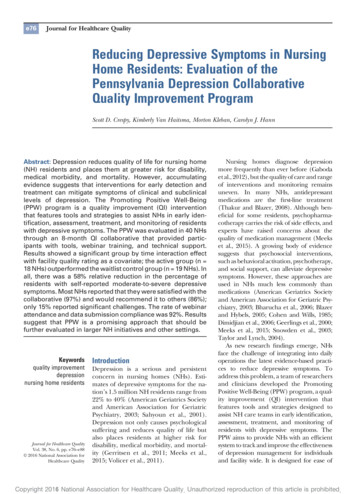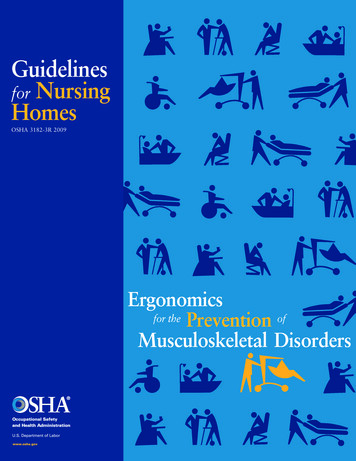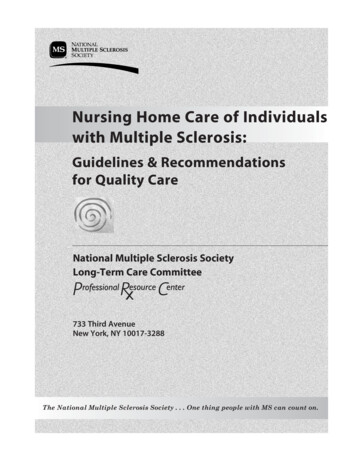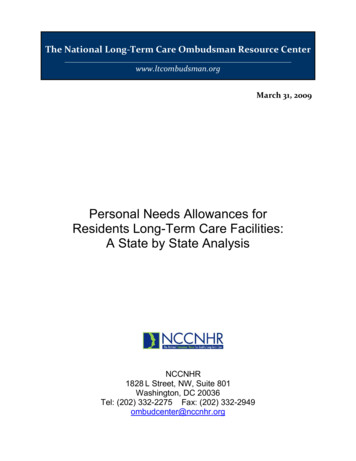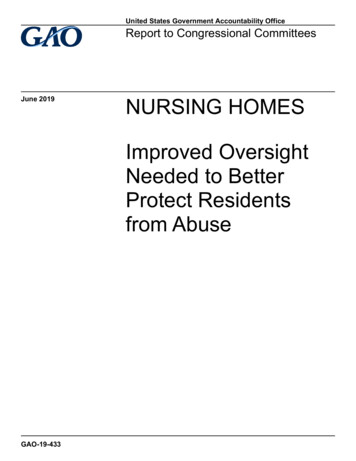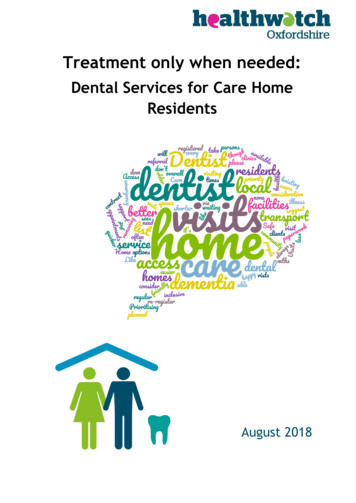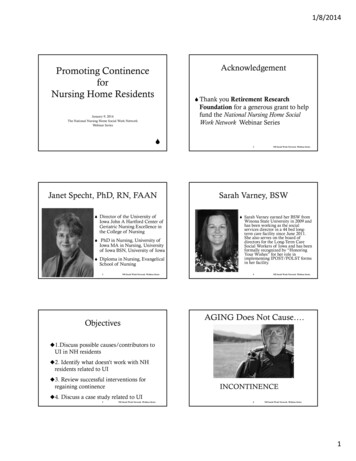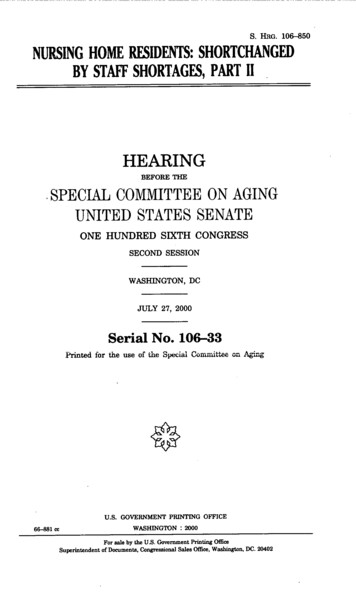
Transcription
S. HRG. 106-850NURSING HOME RESIDENTS: SHORTCHANGEDBY STAFF SHORTAGES, PART IIHEARINGBEFORE THE,SPECIAL COMMITTEE ON AGINGUNITED STATES SENATEONE HUNDRED SIXTH CONGRESSSECOND SESSIONWASHINGTON, DCJULY 27, 2000Serial No. 106-33Printed for the use of the Sp L'ai Coasiit'ee on AgingU.S. GOVERNMENT PRINTING OFFICE66881 ccWASHINGTON: 2000For sale by the U.S. Government Printing OfficeSuperintendent of Documents, Congressional Sales Office, Washington, DC. 20402
SPECIAL COMMITTEE ON AGINGCHARLES E. GRASSLEY, Iowa, ChairmanJAMES M. JEFFORDS, VermontJOHN B. BREAUX, LouisianaLARRY CRAIG, IdahoHARRY REID, NevadaCONRAD BURNS, MontanaHERB KOHL, WisconsinRICHARD SHELBY, AlabamaRUSSELL D. FEINGOLD, WisconsinRICK SANTORUM, PennsylvaniaRON WYDEN, OregonJACK REED, Rhode IslandCHUCK HAGEL, NebraskaSUSAN COLLINS, MaineRICHARD H. BRYAN, NevadaMIKE ENZI, WyomingEVAN BAYH, IndianaBLANCHE L. LINCOLN, ArkansasTIM HUTCHINSON, ArkansasJIM BUNNING, KentuckyTHEODORE L. TarMAN, Staff DirectorMICHELLE EASTON, Minority Staff Director(11)
CONTENTSPageOpening statement of Senator Charles E. Grassley . .Statement of Senator Tim Hutchinson .Statement of Senator Conrad Burns .Statement of Senator Jack Reed .1345PANEL INancy-Ann Min DeParle, Administrator, Health Care Financing Administra.tion, Washington, DC .6PANEL IIDr. Andrew Kramer, Professor of Geriatric Medicine, and Research Director,.Center on Aging, University of Colorado, Denver, CO .John F. Schnelle, Borun Center for Gerontological Research, Los AngelesJewish Home for the Aging, UCLA School of Medicine, Los Angeles, CA .2634A DDli'NXTVTStatement of Representative Pete Stark .Statement of Dr. Charles H. Roadman II, President and CEO of the American.Health Care Association .Article from the Star Tribune, For proper nursing home staffing .Statement of AAHSA President Len Fishman .Statement of the National Citizens' Coalition for Nursing Home Reform .Testimony submitted by Ingrid McDonald, Senior Policy Analyst, Service.Employees International Union .Statement from the American Federation of State, County and MunicipalEmployees.Testimony submitted on behalf of the Center for Medicare Advocacy, Inc . .Testimony submitted oiu oehalfa of the Department of Social -nd Behavirnal.Sciences, University of California .Testimony of the American Nurses Asscociation .Comments submitted by University of California, Department of Social andBehavioral Sciences .Comments submitted by Paraprofessional Healthcare Institute .Comments and Questions by the National Committee to Preserve Social Security and Medicare .Comments submitted by William Painter, Long Term Care Public Policy.and Client Quality of Life .Testimony submitted by U.S. Public Health Service .Testimony submitted by the American Association of Nurse Assessment Coordinators .A letter from The National Association of Directors of Nursing Administrationin Long Term Care .Testimony from Betty MacLaughlin Frandsen, RN, NHA, NADONA, Pennsylvania Chapter .Letter from Constance Holleran, RN, MSN, FAAN . .Letter from Phyllis Peavy, Hockessin, DE .Comments and Observations from Sheryl Miller, College of Nursing, Univer.sity of Iowa, Iowa City, IA .Letter submitted by Janet K. Pngle Specht, PhD, RN, Assistant Professor,College of Nursing, University of Lowa .Letter submitted by the Nursing Service Group, Barrington, IL 143145148151153
NURSING HOME RESIDENTS: SHORTCHANGEDBY STAFF SHORTAGES, PART ITHURSDAY, JULY 27, 2000U.S. SENATE,SPECIAL COMMrITEE ON AGING,Washington, DC.The committee met, pursuant to notice, at 9:36 a.m., in roomSD-628, Dirksen Senate Office Building, Hon. Charles E. Grassley,(Chairman of the Committee) presiding.Present: Senators Grassley, Burns, Hutchinson, Wyden, Reed,and Lincoln.OPENING STATEMENT OF SENATOR CHARLES E. GRASSLEY,flnvrnt?The CHAIRMAN. Good morning. I normally do not start the meeting until Senate Breaux arrives, but I have been told that he is onhis way, so I think I will take advantage of a few seconds to makemy opening comments and then go to others for opening comments.I want to say good morning to everybody who is here as this committee looks into the situation with nursing homes, both from thestandpoint of Congress' job as oversight and from the standpoint ofthe Health Care Financing Administration doing its work, andfrom the standpoint of stakeholders as well. But most importantly,we are all here today because we are concerned about the qualityof care and the expenditures of taxpayers' money, the 39 billionspent out of the Treasury, various Federal programs, mostly Medicare and Medicaid, for nursing homes.For more than 2 years, our Special Committee on Aging hasworked to improve the quality of care in nursing homes. We havelearned that too many nursing home residents suffer from bedsores, malnutrition, and dehydration.One cannot help but wonder why these horrible conditions exist.Again and again, family members and other advocates tell us thatthe answer is that there is too little nursing home staff. They havegiven us many, many anecdotes illustrating what staffing shortages mean to nursing home residents. I only want to mentionthree, but we could go on and on for an entire meeting with anecdotal evidence that has come to us, and 2 years ago, we heard someof this presented in our hearings.A daughter finds her mother unbathed, unfed, and lying in hersoiled pajamas at 11 a.m. in the morning.A doctor documents a resident's sharp weight loss since admission to a nursing home.(1)
2An emergency room worker reports that a resident's bedsore ishuge, bone-deep, and infected.These incidents obviously turn the stomach and hurt the conscience. They beg for a solution. The first step toward reaching asolution is documenting the problem, and that is why we are heretoday.We have the initial phase of the more comprehensive study ofnursing home staffing shortages that has ever been done to date.The study links staffing shortages to poor care. This is a very common-sense relationship, but it has not been well-documented untilnow. Ten years ago, Congress mandated this study. It was supposed to be done in 1992. I do not understand why it was not donethen or why it has taken so long thus far.The well-being of 1.6 million nursing home residents hangs inthe balance. Now, of course, we have to make up for some losttime. The study is disturbing. It suggests that more than half ofour nursing homes fall below the bare minimum staffing levels.Fifty-four percent of nursing homes have less than the minimumstaffing level for nurses' aides. Last November, this committee convened a forum to learn about nurses' aides and the role they playin the nursing home. We heard that they are the least-trained andthe least-paid of all nursing home staff, yet these people do themost physical of work.For less than 7 an hour, nurses' aides feed and bathe patientsand turn them to prevent bedsores. They sometimes have as manyas 15 to 30 patients per shift. A nurses' aide is a nursing homeresident's lifeline. Too few nurses' aides, consequently too many patients suffer.What do we do with this new information? That is why we arehere today. Should Congress mandate minimum staffing levels fornursing homes? Maybe we should. But first, we need two morepieces of this puzzle. The first piece is the second piece of the studythat is before us today.Today we have a very good start, but the second phase will haveeven more detail, including the cost of implementing minimumstaffing requirements, so I hope the second phase comes quickly.Another necessary piece of information is an analysis of how thenursing home industry spends its money. Nursing homes accept 39 billion a year of taxpayer money for the care of residents.Where does the money go? Is 39 billion a year enough to get thejob done? The General Accounting Office is studying this moneytrail, and they are doing it at my request. I will not receive thatreport until early next year.However, I have two immediate action items. First, I know thatCongress is considering a proposal to give the nursing home industry some of the Medicare money that we cut in the Balanced Budget Act of 1997. We expect a replenishment bill to be up sometimein September.Based ohi today's report, I am not willing to give the nursinghome industry a blank check. The industry has argued repeatedlythat it needs more money to hire more staff. If the industry receives more money this year, I would like to see that increase tiedto staffing, and I plan to develop a proposal to that effect. Today's
3first witness, the administrator of the Health Care Financing Administration, is willing to explore this idea with me.Second, I plan to look into options that would encourage Statesto increase Medicaid rates of nursing homes if they agree to hiremore staff with the increased rates. As many people know, the majority of revenue in nursing homes is Medicaid and not Medicare.My proposal will take some time to develop, and I plan to makeit a priority and will turn to various stakeholders for assistance, including the State governments that we have to deal with on thisissue.The bottom line, then, is that the taxpayers pay for nursinghome care. The taxpayers deserve to know where this money goes.Our first witness is Nancy-Ann Min DeParle. She is Aministratorof the Health Care Financing Administration, and she has responded to our request to come today, at a very difficult time, andhas rescheduled her own schedule to be here with us, because thisis a very important issue to her as well. I welcome her interest inworking with me on nursing home shortages.Our next two witnesses, who I will introduce now but will notcome to the table until after Ms. Min DeParle has concluded, areDr. Andrew Kramer, who is with the University of Colorado HealthCenter on Aging in the Division of Geriatric Medicine; and Dr.John F. Schnelle, from the Borun Center for Gerontological Research at the Los Angeles Jewish Home for the Aging, and also onthe staff of the UCLA School of Medicine.Now, I will call on members in the order in which they arrivedSenator Hutchinson, Senator Burns, and Senator Reed of Rhode Island, with the exception that if Senator Breaux comes, I will allowhim to make his statement before any of the rest of you.Senator Hutchinson, please proceed.STATEMENT OF SENATOR TIM HUTCHINSONSenatur HU-1WcSON. 1Thn-k you, Mr. Chairman.I highly commend you for holding this hearing of the SpecialCommittee on Aging today to examine nursing home staffing requirements and their impact on quality of care for nursing homeresidents.Almost 1.6 million Americans reside in approximately 17,000nursing homes. These residents, as you have rightly pointed out,are the most vulnerable in our society. About half of them need assistance with feeding, and about one in five residents totally depend on assistance.There is indeed a crisis that is happening in our nursing homes,and I am sure a big part of it involves the staffing. Some of theanecdotes that have been pointed out by today's witnesses underscore that crisis.But we also have a crisis in the fact that the availability and accessibility to nursing homes is in jeopardy. In the last 2 years, fourmajor nursing home chains in this country declared bankruptcy. Asyou pointed out in your statement, Mr. Chairman, unemploymenthas been so low that it has been difficult to retain qualified workers, and the salaries being paid to nursing home staff certainlymake it more difficult to get the kind of quality of workers that weneed.
4Seriously ill and chronically ill patients are living longer todaythanks to advances in medical technologies, which is a good thing,but it exacerbates the situation with nursing homes and adds tothe nursing home crisis.And last but certainly not least, Federal reimbursements fornursing homes have dropped significantly, leaving many nursinghomes in dire straights as they try to meet the staffing needs thatthis report has identified. I am therefore glad that the Senate isexpected to consider another Medicare giveback bill this fall.I note in the executive summary of the report that it does notinclude any specific recommendations, and the potential establishment of a regulatory minimum ratio requirement will require further research in more States in order to assess relative costs andbenefits. In addition, more research will be required to assess thefeasibility of implementing minimum ratio requirements.So I join the chairman in hoping that the additional research andthe second phase of this report come quickly.We bear some of the responsibility, I believe, in the reductionsthat have occurred in nursing homes, and while it is good and appropriate that the GAO follow the money and determine how thoseFederal tax dollars are being spent, we cannot expect an industryto provide better services with greater care if we continue tosqueeze the reimbursement rate.I hope that with our consideration of new Federal staffing requirements, Mr. Chairman, that we will also recognize the need toprovide sufficient resources to ensure that those requirements canin fact be met.Again, thank you for holding this hearing today.The CHA DmAN.I agree with you on your last point. This is something that we bear responsibility for and have to look at; but also,in the process of more money, we need to make sure that it goesfor the quality of care that we seek.Senator Burns, and then Senator Reed of Rhode Island.STATEMENT OF SENATOR CONRAD BURNSSenator BuRNS. Thank you, Mr. Chairman.I want to associate myself with the words of my good friend fromArkansas, that we do bear some responsibility. Last year, I thoughtwe put a significant amount of money toward shoring up reimbursements to nursing homes, and what I am hearing from my operators in Montana is that we have not seen that money, but westill have a cadre of investigators and these kinds of people running around our units, harassing patients and caregivers alike. SoI am really concerned about that and about the regulations end ofit-although we must have regulations, and we understand that.So I will just submit my statement, because I want to hear fromthe Administrator of HCFA and then ask some questions. I thinkwe can learn a lot more that way, than just batting around thebreeze amongst ourselves up here.Thank you, Mr. Chairman, for having this important hearing.The CHARASN. Thank you.Senator Reed.
5STATEMENT OF SENATOR JACK REEDSenator REED. Thank you, Mr. Chairman, and I thank you forconvening this hearing regarding HCFA's report on the quality ofnursing homes throughout the country.One of the critical issues they have identified and you and ourcolleagues have commented upon is the lack of adequately trainedstaff in these nursing facilities. In my home State of Rhode Island,there is a particularly critical shortage in certified nursing assistants. These are men and women who serve as critical caregiversin nursing homes. We have not a shortage of licensees-there are26,000 individuals in Rhode Island who are licensed to be CNAsyet only 14,000 are employed in nursing homes. The principal reason, which the report illustrates, is wages and compensation. Asyou pointed out, Mr. Chairman, one of the biggest components ofthe revenue stream for nursing homes is Medicaid funding, followed by other Medicare Programs. When we put the pressure onthose funds, it does not allow for the level of wages which are competitive in this very hot market.As a result, in Rhode Island, we are seeing a huge turnover aspeople leave nursing home jobs. The turnover rate in 1999 was anunprecedented 82.6 percent.It turns out,, again. if you look at the wage structure, a hotelmaid can start off at 9.50 an hour while the typical starting wagefor a CNA is 7.69 an hour, and I would argue that CNA's havea much more challenging and sensitive role to play.So we have a situation that we must address, because our responsibility is to provide quality care for our seniors. It is going torequire not only looking closely at this study but committing ourselves to fund the resources necessary to attract qualified individuals into nursing homes and keep them there.I thank you, Mr. Chairman, for your attention to this issue.The CHAIRMAN. Thank you.Now I will turn to the Director of the Health Care Financing Administration, who has appeared before our committee many years.Since our hearings 2 years ago, she and her staff have workedclosely with us to monitor the States' enforcement of Federal regulations and our own oversight of those Federal regulations. So weappreciate that ongoing dialog that we have had with you. We stillhave a way to go, as I am sure you would recognize, and even today's report says so, but at least there is a process in place so thatthere is cooperation rather than antagonism.Please proceed.
6STATEMENT OF NANCY-ANN MIN DEPARLE, ADMINISTRATOR,HEALTH CARE FINANCING ADMINISTRATION, WASHINGTON,DCMs. DEPARLE. Thank you, Mr. Chairman and distinguished committee members.I appreciate the opportunity to be here this morning to discussthe need for adequate staffing to ensure quality care in our Nation's nursing homes. Protecting nursing home residents is a priority for this Administration and for me personally, Mr. Chairman,as you know; and getting this report done for you was a priorityfor me.1 want to thank this committee, too, for providing so much helpto us in our efforts to work on this issue of improving quality ofnursing homes. And in particular as you are now considering thebudget.for this year I want to thank you, Mr. Chairman, for thehelp you have provided us in getting additional funding in the pastfor our survey and certification efforts, which are so vital to ensuring that quality standards are maintained, and I hope you will beable to help us again this year, because as you know, we have achallenge there.We are just now completing the first phase of extensive researchon the issue of staffing, and we are sharing this morning with thecommittee our preliminary findings and also describing the remaining challenges that are ahead of us, and each of you has describedsome of those challenges this moWe made the draft report available, Mr. Chairman, to you lastnight, although the final one is not yet completed. Our findings todate show a strong association between stnglevels and qualitycare. Now, as you said, Mr. Chairman, this seems like commonsense, and to all of us, I think it may seem intuitive, but the factis that this is the first time ever that a clear relationship betweenstaffing levels and quality of care has been' demonstrated in a statistically valid way. We have all heard the anecdotes, and I agreewith you that they are very upsetting, but this is the first time thatwe have had statistically valid representation of that relationshipbetween staffing levels and quality of care, so it is very significant.I think it marks a significant step forward in understanding thisrelationship between quality and staffing. The findings demonstrate that there are significantly more problems in facilitieswith less than 12 minutes of registered nursing care, less than 45minutes of total licensed staff care, and less than 2 hours of nursing aide care per resident per day. I want to emphasize that theseare minimums, and they do not necessarily describe optimal situations, but it shows a clear relationship if you go below those levelsof staffing with additional problems.The results are very troubling and very disturbing and suggestthat many facilities may need to increase staffing levels. With usthis morning, as you mentioned, are Dr. Kramer from the University of Colorado and Dr. Schnelle from UCLA, and they were theprincipal investigators who did the work on this study, and I knowthe committee will have more detailed questions for them abouttheir work.The results at this point, as you emphasized, Mr. Chairman, arepreliminary, and they represent the first step-and I think it is a
7big step-in taking action to address staffing issues and improvenursing home quality.I think we have a lot of hard work ahead of us at our agency,and we have a lot of hard work ahead of us working together withyou.We are now working hard on several necessary additional efforts.We are working to refine ways to adjust for the case mix or severity of illness and the amount of care required by patients in a givenfacility. We think this work is important to tailor the results andtailor minimum staffing level requirements, if we decide those arefeasible, to individual facilities.We believe that we should expand our studies beyond the threeStates included in the research so far, and those States are Ohio,Texas, and New York. We included almost 2,000 nursing homes,and we think it was a very robust analysis, but we want to expandit further to make sure that it is predictive across other States.We need to validate these findings with individual case studiesof specific facilities, and we are in the middle of that right now;and we need to determine the costs and feasibility of implementingminimum staffing requirements, because what this Congress askedus to do was to look at the feasibility, and I think you have allraie that. eost is an issue here, and we need to look at that aswell.Earlier this year, we began to post data on the number and typesof staff at individual nursing homes on our Medicare.gov website's"Nursing Home Compare" page. I mention that, Mr. Chairman, because I think one of the most important things is to make the public aware of staffing and that it is an issue, and that it is something they should consider when they are looking at a nursinghome.As evidence that people are hungry for this information, it is byfar the most nopular section of our consumer-oriented Medicare.govsite, with some 500,000 page views per month. It is a key part ofour efforts to try to increase nursing home accountability by making information available to the public and, if I may say so, toother nursing homes. And I think it helps to promote better qualityby the nursing homes themselves seeing this information and realizing how they compare with other nursing homes.As we continue our research on staffing levels, we want to workwith this committee and with the Congress, as well as with Statesand industry and labor and consumer advocates, to evaluate waysto ensure that all nursing home residents receive the quality carethey deserve.As you mention and as your colleagues here have mentioned,these strategies could include minimum staffing levels, but theyshould also include things like improved training, increased dissemination of performance data, and enhanced intensity of surveyand certification practices.The research that we are unveiling today is groundbreaking. Itsresults I think are disturbing and troubling, and we are workingdiligently to take necessary next steps for determining the costsand the feasibility of implementing minimum staffing requirements.
8We look forward to continuing our partnership with you as wemove forward, and I thank you again for holding this hearing andfor bringing attention to this very important issue.[The prepared statement of Ms. DeParle follows:]
9Testimony ofNANCY-ANN DEPARLE, ADMINISTRATORHEALTH CARE FINANCING ADMINISTRATIONonNURSING HOME STAFFINGbefore theSENATE SPECIAL COMMITTEE ON AGINGJuly 27, 2000Chairman Grassley, Senator Breaux, distinguished Committee members, thank you for invitingme to discuss the need for adequate staffing to ensure quality care in nursing homes. We arecompleting the first phase of extensive research on this issue, and appreciate this opportunity toshare our preliminary findings and describe remaining challenges.,Our findings to date show a strong association between staffing levels and quality care. This isthe first time ever that a clear relationship between staffing levels and quality of care has beendemonstrated in a statistically valid way, and marks a major step forward in understanding thatrelationship. The findings demonstrate that there are significantly more problems in facilitieswith tess than i2 minutes ofregisiered wursing care, less han 45 minutes of tota! licensed staffcare, and less than 2 hours of nursing aide care per resident per day. The results are troubling,and suggest that many facilities may need to increase staffing levels.However, the results at this point are preliminary and represent only the first step in taking actionto address staffing issues and improve nursing home quality.We are now working to:*refine ways to adjust minimum staffing requirements for the case mix, or severity ofillness and amount of care required by patients in a given facility;*expand our studies beyond the three States included in research so far;*validate the findings with individual case studies of specific facilities;*determine the costs and feasibility of implementing minimum staffing requirements.Meanwhile, earlier this year, we began posting data on the number and types of staff atindividual nursing homes on our medicare.gov website's 'Nursing Home Compare' page. This isby far the most popular section of our consumer-oriented Intemet offerings, and is a key part ofour comprehensive efforts to increase nursing home accountability by making information on
10each facility's care and safety record available to residents, families, care givers, and advocates.BACKGROUNDProtecting nursing home residents is a priority for this Administration and our agency. Some 1.6million elderly and disabled Americans receive care in approximately 16,500 nursing homesacross the United States. The Medicaid program, in which States set reimbursement levels, paysfor the care of the majority of nursing home patients, while the Medicare program pays for careof about 10 percent of patients. The federal government provides funding to the States toconduct on-site inspections of nursing homes participating in Medicare and Medicaid and torecommend sanctions against those homes that violate health and safety rules.In July 1995 the Clinton Administration implemented the toughest nursing home regulationsever, and they brought about marked improvements. However, both we and the GAO found thatmany nursing homes were not meeting the requirements and the State enforcement efforts wereuneven and often inadequate. Therefore, in July 1998, President Clinton announced a broad andaggressive initiative to improve State inspections and enforcement, and crack down on problemproviders. To strengthen enforcement, we have:expanded the definition of facilities subject to immediate enforcement action without anopportunity to correct problems before sanctions are imposed;identified facilities with the worst compliance records in each State, and each State haschosen two of these as 'special focus facilities' for closer scrutiny;provided comprehensive training and guidance to States on enforcement, use of qualityindicators in surveys, medication review during surveys, and prevention of pressure sores,dehydration, weight loss, and abuse;instructed States to stagger surveys and conduct a set amount on weekends, earlymornings and evenings, when quality and safety and staffing problems often occur, sofacilities can no longer predict inspections;instructed States to look at an entire corporation's performance when serious problems areidentified in any facility in that corporate chain, developed further guidelines forsanctioning facilities in problem chains, and collected State contingency plans for chains*with financial problems;required State surveyors to revisit facilities to confirm in person that violations have beencorrected before lifting sanctions;instructed State surveyors to investigate consumer complaints within 10 days;developed new regulations to enable States to impose civil money penalties for eachserious incident; and
11met with the Department's Departmental Appeals Board to discuss increased work loaddue to the nursing home initiative.We also are now using quality indicators in conjunction with the Minimum Data Set thatfacilities maintain for each resident. These quality indicators furnish continuous data about thequality of care in each facility and allow State surveyors to focus on possible problems duringinspections, and it will help nursing homes identify areas that need improvement.In addition, we have been working to help facilities improve quality. For example, we have:posted best practice guidelines at hcfa.gov/medicaid/siq/siqhmpg.htm on how to care forresidents at risk of weight loss and dehydration;been testin
The well-being of 1.6 million nursing home residents hangs in the balance. Now, of course, we have to make up for some lost time. The study is disturbing. It suggests that more than half of our nursing homes fall below the bare minimum staffing levels. Fifty-four percent of nursing homes have less than the minimum .
